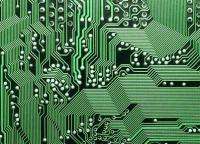October 19, 2009 feature
Running electronics using light

(PhysOrg.com) -- "If you open up almost any electronic gadget, you will see various elements that operating using electric circuitries," Nader Engheta tells PhysOrg.com. "Many of them have different functionalities, such as inductors, capacitors, resistors, transistors, and so forth. These well-known elements have been around for decades. But what if you could bring these concepts to the nanoscale, and what if they could operate with light instead of electricity?"
Engheta, a scientist at the University of Pennsylvania, along with Andrea Alů, believe that it is possible to create a nanoscale circuit board that has the potential to be useful in communications. Engheta and Alů describe their concept of an optical nanoscale circuit in Physical Review Letters: "All-Optical Metamaterial Circuit Board at the Nanoscale."
"If you go to the nanoscale," Engheta explains, "you would have to conceive of nanoparticles that effectively act like the elements seen in current devices. It would be necessary to create nanoparticles of a specific shape, and made from specific materials, that would allow them to act as capacitors, resistors, and other well-known elements."
There are three main advantages of using optical nanoparticle circuit boards, Engheta says. First of all, being able to further miniaturize various communications devices would ensure that technology continues to evolve. “We are moving toward having more and more information compacted into a smaller volume.” The second advantage is that using optical frequencies would provide more bandwidth. Finally, there is a very real possibility that nanoscale circuit boards, properly constructed, would use less energy. “We have to look more into this possibility, but it is quite likely that optical nanoparticle circuit boards would be low energy in nature,” Engheta insists.
So far, Engheta and Alů have only used computer simulations to test their ideas related to nanoscale circuit boards. The Engheta group is, however, working toward an experimental realization of their theories with a proof of concept for lumped circuit elements. “What we’ve come up with is compatible with the nanofabrication techniques already in use today,” Engheta says. “We are in the midst of trying to construct some nanowires to serve as our proof of concept for lumped optical circuit elements, and hopefully we’ll see some results in the next six months or so.”
One of the biggest challenges to realizing this type of nanoscale circuitry is that it is difficult to form the structures needed at such a small size. “Additionally,” Engheta admits, “we would have to put these structures next to each other in specific patterns. This is doable, using present nanofabrication techniques, but not easy.” The fabrication process would include creating structures out of metamaterials and a process that imitates the electronic circuitry we are more familiar with. “One of our ideas is to cut a groove in the material, one that could contain the light used in the circuit board, to connect nanoparticles together. It would be similar to the way wires connect various elements in electronic devices.”
Once a proof of concept is realized for this circuit board, Engheta hopes to take optical nanocommunications to another level. “We are extending our concept to other elements that are non-linear,” he says. “This could allow us to develop switches, opening the door to computation.”
More information: Andrea Alů and Nader Engheta, “All Optical Metamaterial Circuit Board at the Nanoscale,” Physical Review Letters (2009). Available online: link.aps.org/doi/10.1103/PhysRevLett.103.143902
Copyright 2009 PhysOrg.com.
All rights reserved. This material may not be published, broadcast, rewritten or redistributed in whole or part without the express written permission of PhysOrg.com.

















